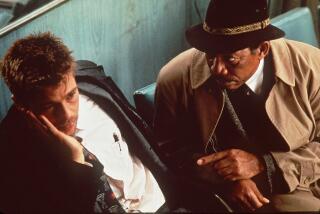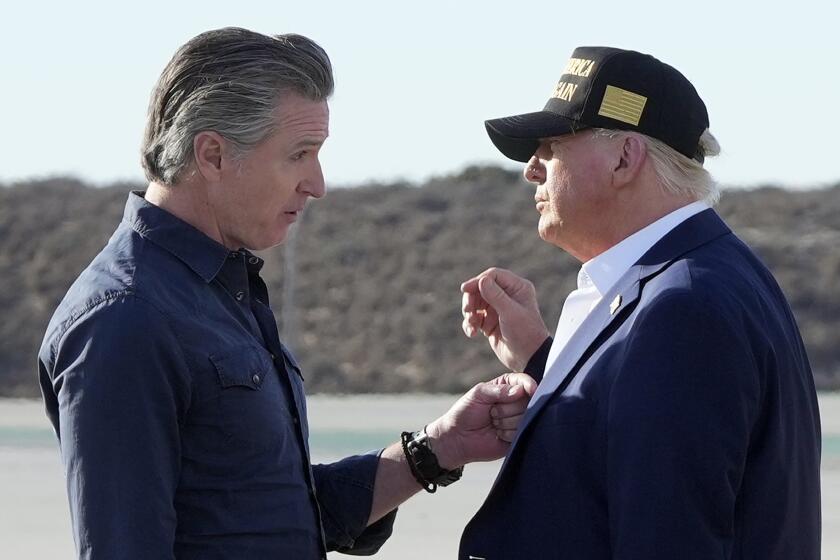Trapped down in the depths
- Share via
THE scene opens with a herd of duckbill dinosaurs gorging on kelp. A Tyrannosaurus rex, towering 22 feet, suddenly appears, unleashing a blood curdling roar as its prey scatter, but one duckbill dinosaur remains trapped in the water.
The T-Rex crashes through the surf and ruthlessly rips him from the sea. It suddenly stops -- sensing a powerful presence in the water. Its red reptilian eyes, glowing like lasers, scan the ocean. A massive creature hidden in its own towering wave explodes out of the water. The T-Rex is rocketed off its feet with an anguished roar, flipped onto its back with its feet in the air and spun like a cylinder as it is dragged beneath the water. A slick pool of blood floats on the surface.
We’ve witnessed a prehistoric homicide but the identity of the undersea killer remains a complete mystery . . . .”
Thus begins “Meg,” a screenplay by Shane Salerno based on author Steve Alten’s 1997 bestselling pulp novel about a Carcharodon megalodon, the 80-foot, 70,000-pound shark that roamed the Earth’s oceans millions of years ago. When the book was first published, Alten figured that his story about a prehistoric being that mysteriously resurfaces from geothermal layers of the oceans’ deepest gorge -- the Mariana Trench -- to terrorize the modern world would make for a great summer popcorn movie, “Jaws” for a new generation. So did Hollywood.
But a dozen years later, Alten, who resides in Florida, is still looking for a studio to make a film of “Meg,” after Disney’s Hollywood Pictures and then New Line Cinema each developed the project but ultimately passed on producing it. “I thought the movie would have been out and we’d be in sequels now,” Alten said. “We think we have a billion-dollar franchise. . . . Unfortunately, the timing hasn’t worked out.”
In recent weeks, however, a new financier has stepped forward with plans to finally bring “Meg” to the big screen. Apelles Publishing Inc. of Abington, Va., has optioned the rights from Alten with veteran Hollywood producers Lawrence Gordon (“Die Hard”) and Lloyd Levin (“Boogie Nights”), along with Virginia-based film financing consultant Belle Avery, set to produce. Gordon and Levin have a track record of taking projects put in turnaround at one studio and successfully setting them up at another, the latest examples being “Watchmen” at Warner Bros. and “Hellboy II: The Golden Army” at Universal.
But the story of how “Meg” went from a white-hot book property to a troubled movie project illustrates the difficulties studios face when developing large-scale action movies, especially when they’re set on the water (“Jaws” and “Waterworld” being two legendary examples). It also provides a behind-the-scenes look at how a studio -- in this case, New Line -- grappled with a project for years but couldn’t figure out how to make it work, even after investing millions.
After a 40-year run, New Line -- the company that made the blockbuster “Lord of the Rings” trilogy, and more recently, the expensive but underperforming “The Golden Compass” -- was recently folded into parent company Warner Bros. after essentially three years of box-office flops (with a few exceptions). More and more these days, success in Hollywood depends on betting on big-budget franchises, and at one point, New Line seemed poised to gamble on “Meg,” which had obvious sequel potential. The studio hired director Jan de Bont (“Speed”), who brought in a team of special effects and production experts to assist him, and even pre-sold rights on the picture to foreign distributors. But after 2 1/2 years in development, the studio pulled the plug.
New Line cited a number of factors that went into its decision to cut bait on “Meg” -- primarily because it says the risks ultimately outweighed the benefits. “The script needed a lot of work; it was very expensive; and we did not choose the director or producers, who were already attached,” a New Line spokeswoman said in a statement e-mailed to The Times.
But others involved see it differently: “It was a completely blown opportunity,” lamented De Bont. “It is such a fantastic subject matter.”
In the summer of 1995, Alten had read a magazine article about the Mariana Trench and thought, “What if a shark lived down at those incredible depths?” Thus, “Meg” was born. During the day, Alten worked as manager of a wholesale meat company. At night, he would stay up until 3 a.m. writing his book. Then in 1996, on a Friday the 13th, he was fired from his job. But four days later, his book idea paid off big-time.
Disney snatched up the film rights before the manuscript was even sold. The book then became the object of a bidding war among New York publishers with Bantam/Doubleday signing Alten to a two-book deal worth $2.1 million. The novel became the hit of the Frankfurt Book Fair, the largest in the world, with foreign rights sold to 24 countries for more than $1.3 million. The book has since spawned three sequels, with the latest, “Meg: Hell’s Aquarium,” scheduled for release in summer 2009.
Alten had high hopes after his book was sold to Disney but grew frustrated when the scripts the studios developed veered wildly from his novel.
“They stuck wings on the shark,” Alten recalled with a laugh. “I’m not kidding! They wouldn’t listen to anything I had to say. My role has got to be to keep the science and not the ridiculousness for Hollywood’s sake. One screenwriter had the shark growling.”
Regaining momentum
In 1998, Hollywood Pictures -- embroiled in a management shake-up and with rival studio Warner Bros. doing a competing shark picture, “Deep Blue Sea” -- decided to put “Meg” in turnaround, Alten recalled. That same year, “The Trench,” Alten’s sequel to the “Meg” novel, was released and also became a bestseller.
After several years with no movement on the project, Alten wrote his own adaptation. He showed the script to Nick Nunziata, creator of the movie website CHUD.com, who had loved the novel and thought it would make a hit film. Nunziata, in turn, showed the script to director Guillermo del Toro. He, in turn, showed the script to Gordon and Levin, whom he had worked with on “Hellboy.” The producers then approached De Bont, whom they had worked with on “Lara Croft Tomb Raider: The Cradle of Life.”
“From the beginning, I loved the project,” De Bont recalled. “It’s like an adventure. It stimulates your imagination.” To this day, he even keeps a megalodon’s tooth in his office.
In August 2004, New Line expressed interest in making “Meg” but would not commit to Alten’s script since some felt it too closely resembled “Jurassic Park.” So, the studio hired screenwriter Salerno (“Armageddon”) to write a new script.
On April 10, 2005, Variety reported that “Meg” had been picked up by New Line with Gordon and Levin producing along with Del Toro (who would eventually leave the project), De Bont, Nunziata and Alten’s managers, Ken Atchity and Chi-Li Wong. The article also mentioned a fast-tracked release date of summer 2006 and a $75-million budget. New Line was so high on the project that it included “Meg” among its slate of 10 film projects the studio pitched to foreign distributors at the 2005 Cannes Film Festival.
In September, Salerno turned in his first draft, with at least a quarter of the script featuring scenes under water. In a memo dated Sept. 28, 2005, the “Meg” development executives, George Waud and Jeff Katz, who have since left New Line, wrote “to reaffirm how excited we are with the current draft. We both feel that with the changes discussed . . . we will be working with a potential classic here.”
Based on Salerno’s first draft, the studio authorized De Bont to hire a “dream team” of top Hollywood craftsmen with expertise in making big action films. They included visual effects supervisor John Nelson (“Gladiator”), production designer Bill Sandell (“The Perfect Storm”) and line producer Colin Wilson (“War of the Worlds”). By putting together such a team, De Bont was signaling that not only was this a high-profile project, but any concerns the studio might have with the director would be assuaged knowing he had respected experts at his side.
De Bont also developed storyboards, animatics (a series of still images edited together and displayed in sequence with music) and worked with designers to build a 5-foot clay-and-fiberglass scale model of a megalodon so that when he went to New Line to make his presentation, studio executives could visualize what the film might look like. When he finished giving his presentation to New Line, he was greeted by applause.
“He invested a substantial amount of money in art work and mock-ups of how the shark would look like,” recalled Atchity. “He was convinced they were going to do it. They kept saying they were, but we never really got a clear sign from [New Line co-Chairmen] Bob Shaye and Michael Lynne.”
Budget buster
The director also began thinking of a cast, envisioning actor Ken Watanabe as the captain of a Japanese whaling vessel -- a “Hemingway character” who holds to old traditions and doesn’t much like the modern ways of whaling. “It was a fantastic role,” De Bont said.
Then, in November 2005, New Line got a sticker shock. The estimated production budget on Salerno’s first draft soared to $157 million, reinforcing the studio’s worst fears that a film shot largely on water and requiring numerous special effects might wind up costing $200 million. New Line immediately ordered the budget slashed to $125 million.
De Bont, Salerno and line producer Wilson cut more than 200 visual effects shots from the script for an estimated savings of $18.9 million. The scenes that were removed included Meg being attacked by a pack of giant Humbolt squid, Meg devouring a surfer and Meg attacking a low-flying helicopter. De Bont figured he could further trim production costs by filming ocean scenes inside 20th Century Fox’s huge water tank in Rosarito Beach, where director James Cameron had filmed “Titanic.”
On Feb. 27, 2006, New Line production chief Toby Emmerich sent an e-mail stating that he had read the latest script draft and “thought it good” and mentioned he had given it to Shaye. But New Line then demanded more cuts. De Bont recalled Emmerich telling him: “If you bring it down to around $100 million, then [we] will make the movie.” The studio declined an interview request for Emmerich.
Although it appeared that “Meg” was all but dead by early summer of 2006, New Line was still floating various budget estimates. But the “dream team” couldn’t wait any longer for a commitment and departed for other films. Still, New Line wasn’t ready to deep-six “Meg” just yet. Studio executive Richard Brener was put in charge and, sources say, he reassured everyone that the movie would be made.
But on June 6, 2007, after stories had appeared in the media citing New Line’s string of box office failures and rumors of management dysfunction, Atchity sent out an e-mail to the “Meg” team recounting a phone conversation he had with the studio:
“While NL holds rights to ‘Meg’ until 10/30/07, we have not found a way to go on with the movie after all chiefly because physical production does not believe that the budget will hold to $100m -- and we cannot go back to our foreign distributors and ask for overrun increases.”
De Bont said he felt that if he could only get Shaye’s ear things might work out, but reaching Shaye was nearly impossible during this tumultuous period at New Line. The studio’s founder was hospitalized with an infection for a period and later went off to direct his own movie, “The Last Mimzy,” which was co-written by Emmerich.
Bill Mechanic, the former production chief at 20th Century Fox, said New Line isn’t alone in being cautious when betting on a tent-pole picture. At any one time, he noted, a major studio might have 25 to 50 such projects in development and it’s not uncommon for studios to spend years trying to get a franchise made. “X-Men” was seven or eight years in development, he recalled.
“Most of the [tent-pole franchises] come out of big ideas,” Mechanic said. “ ‘Poseidon’ seemed like a good idea but, in retrospect, it was a terrible idea.’ ” On the other hand, he added, “most people thought ‘Titanic’ was a stupid idea and wondered ‘Why are you making a moving about a ship that sinks?’ ”
“Titanic,” of course, went on to become one of the biggest blockbusters of all-time. Whether or not another studio will bet on “Meg” remains to be seen.
“With all due respect, there are a billion movies in the naked city that don’t get made,” said Robert Newman, agent for Del Toro. But “it was not a bad idea for a movie, if done correctly.”
More to Read
The biggest entertainment stories
Get our big stories about Hollywood, film, television, music, arts, culture and more right in your inbox as soon as they publish.
You may occasionally receive promotional content from the Los Angeles Times.










